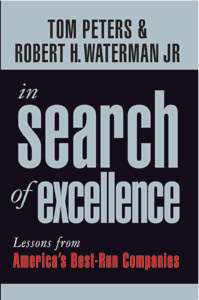excellence

In search of excellence
Tom Peters & Robert H Waterman Jr
Chapter 1 – Successful American Companies
The authors were the part of team doing a project under the aegis of McKinsey & Co on relationship between strategy, structure and management effectiveness.
The team came out with the 7-S framework popularly known as McKinsey’s 7-S
1. Structure
2. Systems
3. Style
4. Staff
5. Skills
6. Strategy
7. Shared Values
While working on the project, the authors came out with a definition of innovativeness which gave a new perspective on excellence. Adding to the old definition of innovation – creative people developing marketable new products – they added innovative companies are especially adroit at continually responding to change of any sort in their environments. This concept of innovation became the benchmark to identify excellent companies/managers.
Working on the project, it was found that excellent companies were above all brilliant on the basics. Tools did not substitute for thinking. Intellect didn’t overpower wisdom. Analysis didn’t impede action. They found that excellent companies worked hard to keep things simple in a complex world. The companies persist and insist on top quality. Such companies fawned on their customers, listened to their employees and treated them as adults. The companies allowed their innovative product and service champions long tethers and also allowed some chaos in return for quick action and regular experimentation.
The eight attributes that emerged to characterized the excellent companies on which the rest of the book dwells are:
1. A bias for action;
2. Close to the customer;
3. Autonomy and Entrepreneurship;
4. Productivity through people;
5. Hands-on value driven;
6. Stick to the knitting;
7. Simple form, lean staff;
8. Simultaneous loose-tight properties.




1 Comments:
Tejbir bhai,
You are reading stuff thats too complicated. :-)
Post a Comment
<< Home